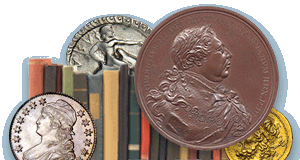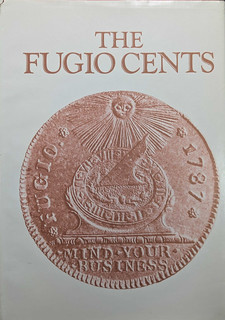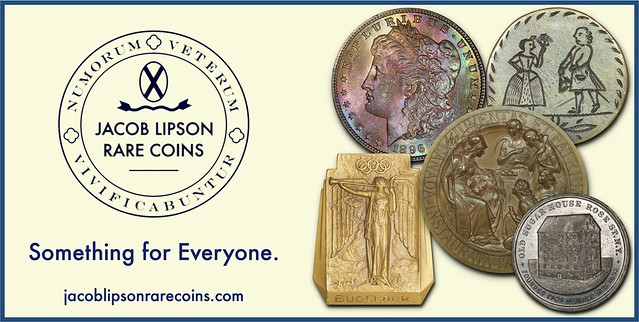
PREV ARTICLE
NEXT ARTICLE
FULL ISSUE
PREV FULL ISSUE
MORE ON ALAN KESSLERE-Sylum Feature Writer and American Numismatic Biographies author Pete Smith submitted this followup article on author Alan Kessler. Thanks! -Editor
More on Alan Kessler
Alan Harvey Kessler was born in New York on August 12, 1938. The 1940 Census finds him living in Manhattan with his father Samuel (1898-1977), mother Rose (1897-1969) and brothers Charles, 14 and Howard, 12. His name is indexed as Allan and the handwriting shows the name Allan with a line through the second ‘l'. For the 1950 Census, the family is at 215 Broadway in Norwich, Connecticut. His father was the owner and manager of an IGA store. Kessler attended Norwich Free Academy. In his freshman year, he was president of the school's newly formed Coin Club. His 1956 senior yearbook photo mentions his other interests. He wanted to be a rocket scientist even then, a year before the 1957 launch of Sputnik I. In 1959, Alan was at the University of Connecticut. A newspaper article reported that he would be included in "Who's Who at American Colleges and Universities." He was listed at 14 Williams Street, Norwich, president of the American Rocket Society and vice president of Eta Kappa Nu, the electrical engineering society. He was married to Judith Rose Carlin (1938-2005) on August 28, 1960, in Wethersfield, Connecticut. They had a daughter Deborah (Parker) and sons Steven and Jonathan. In the period of 1966 to 1968, Kessler ran ads in Coin World. In 1968 he was looking to buy colonial coppers and George III British halfpence. Another ad offered to sell duplicates of his colonial coppers. His address in 1966 was 1105 Lexington Street in Waltham. Massachusetts. In 1967 it was 111 Concord Road in Acton, Massachusetts. Both were near Lexington and Concord in Massachusetts. During the 1960s, Kessler worked as an engineer at MIT Lincoln Laboratories in Lexington, Massachusetts. During this time, he contributed technical articles to Microwave Journal. His address during 1970-1976 was an APO Box in San Francisco. He was working as a defense contractor at Kwajalein in the Marshall Islands. He is linked to articles on radar and missile detection systems. In the April 1969 issue of The Numismatist, Alan H. Kessler is listed as new member R-62213 and address as Box 2012, APO San Francisco, Ca. 96555. The April 1973 issue of The Colonial Newsletter had an article, "A FLOW GRAPH IDENTIFICATION CHART FOR THE FUGIO CENTS" by Alan H. Kessler. The author reported that the chart had been successfully tested by an eleven-year-old girl.
Kessler had already begun to break up his collection before publication of his book. He consigned his Connecticut Coppers to Pine Tree for their February 15, 1975, sale for the Early American Coppers Society Convention. With cataloguing by Walter Breen, the catalog became an important reference work for collectors of the series. This was followed by the 1976 Pine Tree sale with a section for the Early American Coppers Society March 5, 1976. Kessler's New Jersey Coppers were included in the sale and his lots were identified as coming from his collection. Kessler's Fugio Cents, Vermont coppers and remainders from his collection were consigned to NASCA for their Kessler-Spangenberger sale of April 28-29, 1981. His Voce Populi and Nova Constellatio collections were sold privately to Colony Coin Company. After separation from MIT Lincoln Laboratories, Kessler worked for McDonell-Douglas 1977 to 1985, XonTech 1985 to 2003 and Northrop Grumman 2003 to 2007 after their acquisition of XonTech in 2003. Alan's father Samuel died in 1977. His obituary listed Alan as a survivor living in Fountain Valley, California. When his brother Charles died in 1997, Alan was also living in Fountain Valley. He was also reported as a resident of Huntington Beach, California, during 1990-1997. Huntington Beach is adjacent to Fountain Valley. In 2003-2007 he was living in Kapaa, Hawaii. Judith Rose Carlin Kessler died on December 2, 2005, and is buried at Kalapaki Bay Memorial Park in Hawaii. There is a photo of Judith and Alan on the headstone. As far as we know, Alan is still living. Many thanks to Pete for this, and to Julia Casey, Rod Widok, Franklin Noel, Stephen Searle and others who responded or otherwise contributed. -Editor Franklin Noel writes: "Pete Smith's "The Alan Kessler Mystery" in the February 2, E-Sylum reminded me of the first time I attended the ANA Summer Seminar in the 1990's. The class I took was "Colonials," taught by Eric Newman (then a spry octogenarian), Ken Bressett (then still editor of the Redbook), and Tom Rinaldo (then still an active colonial coin dealer). I was not surprised to read in Pete's article, that he found no correspondence between Eric Newman and Alan Kessler in the Newman files. In the Colonials class, when discussing Fugios, Eric had nothing good to say about Alan Kessler. He dismissed Kessler's book as adding nothing to Fugio scholarship. He accused Kessler of simply copying Newman's own work on Fugios, and adding nothing of value. At the time, Newman's own work on Fugios was virtually inaccessible. The internet was in its infancy, Newman's own 2008 Fugio book was still more than a decade away. Indeed, John Kraljevich, a major contributor to Newman's 2008 book, was then a teenage YN, and a fellow student in the Colonials class. Newman's own Fugio work consisted then of only two articles published in Wayte Raymond's, The Coin Collector's Journal, nearly a half century earlier; in Jan-Feb. 1949, and updated in July-August, 1952. Neither were readily available to collectors. Nevertheless, Newman urged us all, in talking or writing about Fugios, to use "Newman numbers," not "Kessler numbers." I remember thinking, if nothing else, I found Kessler's flow charts quite useful in identifying Fugio varieties. But I lacked the confidence to challenge Newman's evaluation of Kessler's book, a readily accessible resource that I owned. I still use Kessler's flow charts to ID Fugio varieties. By the time Newman's own Fugio book came out in 2008, I had acquired many more Fugio varieties, and a tad more confidence. I was disappointed to see that Newman's book adopted the view that Fugios were not "Cents," but denomination-less "coppers." I wrote a brief article that was published in the C-4 Newsletter, establishing that Fugios were, and always had been, "Cents." See, Noel, Franklin, "Fugios: Are They Cents?" C-4 Newsletter, Vol. 18, No. 1 (Spring, 2010) p. 22." Frank's note arrived early in the week, and he added, "I wish Pete luck in his search for Alan Kessler. Maybe he ran off with Don Taxay." Stephen Searle's contributions arrived after Pete had completed his article, but they corroborate his findings. -Editor Stephen Searle added: The article states: "In 1970, his mailing address was Box 2012 APO San Francisco, California 96555. In his 1976 book, his address was given as Box 1685 APO San Francisco, California 96555. These addresses indicated that he was serving in the military." Someone conveniently posted a 1972 school yearbook from Kwajalein (encompassing all grades, elementary through high school) on the internet. Both my sister and I are in it. Anyway, just for grins, I checked if there were any Kesslers and found three. Debbie, Steven, & Jonathan. It is a fairly common name, but any or all of them might be his children. Families often accompanied civilians if they were working on Kwajalein. My father worked for Bell Labs, and our entire family was there for the two year term of his assignment." Later Stephen added: "I found the 1972 Kwajalein phone directory online and he was listed. He worked for MIT Lincoln Labs at the time (US Army contractor)." Check, check, check, check, and check. Ain't it great when things come together? Thanks, everyone!! Apes together, strong. -Editor
To read the earlier E-Sylum article, see:
Wayne Homren, Editor The Numismatic Bibliomania Society is a non-profit organization promoting numismatic literature. See our web site at coinbooks.org. To submit items for publication in The E-Sylum, write to the Editor at this address: whomren@gmail.com To subscribe go to: Subscribe All Rights Reserved. NBS Home Page Contact the NBS webmaster 
|






